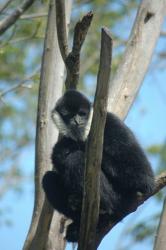New Gibbon Species found to Thrive in Vietnam’s Borders

The German Primate Center (DPZ), primate researchers based in Göttingen, Germany, have identified a new species of gibbon living in the tropical rain forests along Vietnam’s borders. The new rare species under study, the northern buffed-cheeked gibbon (Nomascus annamensis) have been differentiated from the six previously identified breeds, of which, until now, were believed to be the only species of its kind. Northern buffed-cheeked gibbon males have a black pelt that appears silver against sunlight, its chest is brownish in shade and its cheeks are deep orange-golden. Their crests are very prominent.
Gibbons, like orangutans, gorillas, chimpanzees and bonobos belong to the apes, the known closest relatives of humans. Due to their diminutive body size, however, gibbons are called lesser apes. In fact, it may even be one of the smallest monkeys in the world. A distinction is made between the different genera of gibbons, of which the crested gibbons, with their characteristic “punk hairdo,” are the most eye-catching. Male and female animals look quite different. While the females show an orange-yellow pelt, adult males are black and have the characteristic crest. In addition, some species have light-colored cheeks. What they all have in common are long arms and the ability to brachiate, that is, to swing with great accuracy and over considerable distances from branch to branch.
Led by Roos, the German-American-Vietnamese research team who made the discovery believe that finding the northern buffed-cheeked gibbon is significant in the efforts to protect them from wildlife trade and more emphasis can be given and ensure the species survival in the wild. As this attractive little primate can only be found in Vietnam, Cambodia and Laos and its disappearance would be a sad loss.
DPZ, one of the 86 Leibnitz Association research and service institutions in Germany, engages in basic research on and with primates in the areas of organismic biology, infectious diseases, and neurosciences. Even for them, determining gibbon species is particularly difficult, as they live high up in the canopy. Small differences in their coloration are nearly impossible to make out from below, and tranquilizing them for identification purposes is out of the question, as these endangered animals would not survive a fall from such a great height. To make that achievable, the team collected the droppings from the animals in order to read the genetic information available in their intestinal cells. These data were then augmented by a genetic analysis of the animals displayed in museums. The sound recordings from the gibbon calls provided an additional, valuable source of information. From all this data, the team was able to demonstrate the distinction of the northern buffed-cheeked gibbon from other species.
These primates are as yet largely unexplored. However, not many of them survive and are believed to be among the most critically endangered primate in the world. Other species and subspecies are similarly endangered, and some have populations of only around a hundred animals. Though there are several factors that contribute to the decline in their numbers, illegal hunting is among the main hand. Gibbons are also kept as cute pets, while others buy them for culinary uses. They are also often processed into traditional medicines. A further major threat is the increasing loss of their habitat by forest clearing to make way for farming, or to establish rubber, coffee and cashew plantations, or to mine gold or make charcoal, or simply for the timber. This new discovery adds knowledge of their biology and exact distributions which is essential for effectively protecting them. Only if we know where which species is found and how many of them are left where mostly people begin serious conservation actions.









